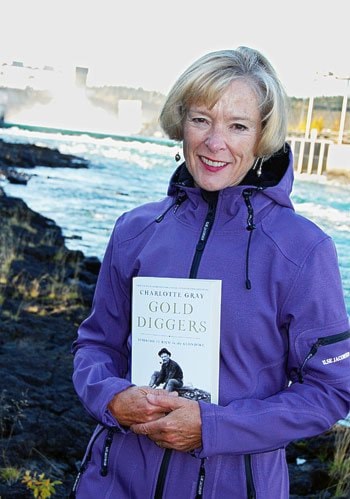What do an imperious colonial columnist for the London Times, a ramrod-straight authoritarian Mountie, an aspiring young self- educated author, a calculating
woman entrepreneur, a selfless saint and a prospector from New England have in common?
Answer: these are the main characters whose lives are deftly interwoven in a new book on the Klondike Gold Rush that is being released September 25. Gold Diggers: Striking it Rich in the Klondike, written by Charlotte Gray, and published by Harper-Collins of Toronto, is a breath of fresh air amidst the stale, often cliched writing that has been produced about the Klondike Gold Rush in the popular press in recent years.
Gray is well known to Canadian readers, having spent many years as a political commentator and magazine columnist. More recently she has published a number of well written biographies of Canadian figures including inventor Alexander Graham Bell, social activist Nellie McClung, and poet E. Pauline Johnson. And she is no ordinary writer. Over the last four decades, Gray has accumulated enough awards for her journalism and book writing to make her trophy shelf sag. In 2007, she became a member of the Order of Canada.
Much has been written about the Klondike Gold Rush, most notably Pierre Berton’s monumental study Klondike, which was published more than 50 years ago. Many subsequent books on the subject have fallen in the shadow of Berton’s work, and most certainly all have been influenced by way Berton’s narrative framed the subject. Sadly, especially during the centennial of the gold rush, far too many books were hurriedly written by authors who cashed in on the Klondike name without having done the research, or contributed any new insights. Often, the authors of these works never even set foot in the Klondike.
Charlotte Gray has succeeded in breaking the mould by presenting a fresh, well-informed and fascinating perspective of the event from which the modern-day Yukon was born
During her recent visit to the Yukon, we took a walk on the Millennium Trail pausing the site of Whitehorse Rapids that played such an important role during the gold rush. She told me her story.
After studying at Oxford University and the London School of Economics, Gray followed her future husband to Canada in 1979 and never looked back. In Canada, she pursued journalism for many years before turning to biography and popular history.
After a series of award-winning biographies, she took a new direction and chose the Klondike as an event of broad, even global scale impact.
Her schooling led her to use primary sources such as diaries and correspondence for her inspiration, and this shaped her choice of characters for Gold Diggers.
From amongst the wealth of information that is available about the gold rush, she turned to the papers of Sam Steele, newly acquired by the University of Alberta, to the letters of Flora Shaw at Oxford University, and to the unpublished memoir of Belinda Mulrooney in Berkeley California, to capture the motivations and emotions of the gold rush.
To further her knowledge of the subject and the place, and provide her with inspiration, she was sponsored by the Dawson Public Library and the Writers Trust of Canada to spend April, May and June, 2008, as writer-in-residence at Pierre Berton House in Dawson City. During that time she soaked up the ambience of the community and the scale and character of the landscape.
“Now I felt the exhilaration,” she said: “The North is different, especially in summer. The hills pulsate with irrepressible light, wildlife regards us as intruders, the silence is intense.”
Gold Diggers covers the gold rush period from 1896 till 1899, viewed through the narratives of prospector William Haskell, business woman Belinda Mulrooney, missionary Father William Judge, author Jack London, journalist Flora Shaw of the London Times, and Superintendent Sam Steele of the North West Mounted Police. Reflecting the demographics of the gold rush, four of the characters are American; one is British, and one Canadian.
Through the lives of these six characters, the events of the gold rush unfold in a clear and gripping account. The Klondike came at a turning point in North American history. The discovery of gold in the Klondike started a crazy mass migration, which was the last and most storied of the nineteenth century gold rushes.
The ordeal that tens of thousands of stampeders experienced in order to reach the Klondike left a more indelible impression in the souls of those who experienced it than all of the gold that was dug up. In fact, it left a permanent mark upon the consciousness of an entire generation.
It brought out the best - and the worst in human nature
Gold Diggers draws the reader into the excitement; through Gray’s writing, we can hear the sounds, sense the smells and shudder from the bitter cold in this remote and frozen place. Better yet, it presents the background to the events in an informed way that dispels the stereotypic view of events and leaves the reader with a clear understanding of what was going on.
Did Haskell find his gold?
How did the Klondike form the future career of Jack London? Why was Flora Shaw outraged by the government administration?
How did Belinda Mulrooney emerge at the top of the heap of entrepreneurs who flocked to the opportunities of Dawson City? Why did Father Judge work himself to death while saving the lives, if not the souls, of so many? How did Steele succeed in imposing order upon the chaos of the Klondike? Only by reading the story for yourself can you find the answers to these questions.
It has taken a transplant from another country to find the gold in Canadian history. It’s up to us now to celebrate it.
Gold Diggers: Striking It Rich in the Klondike, by Charlotte Gray, Harper-Collins, 416 pages, $34.99
